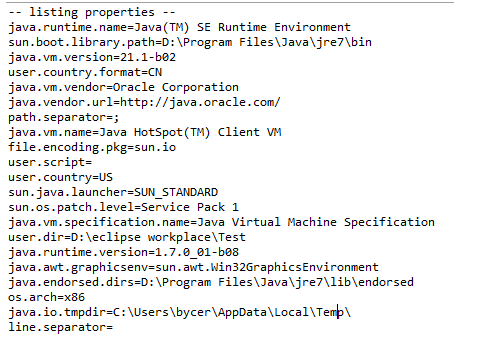知识学而不用,就等于没用,到真正用到的时候还得重新再学。最近在看几款开源模拟器的源码,里面涉及到了很多关于Properties类的引用,由于Java已经好久没用了,而这些模拟器大多用Java来写,外加一些脚本语言Python,Perl之类的,不得已,又得重新拾起。本文通过看《Java编程思想》和一些网友的博客总结而来,只为简单介绍Properties类的相关操作。
一、Java Properties类
Java中有个比较重要的类Properties(Java.util.Properties),主要用于读取Java的配置文件,各种语言都有自己所支持的配置文件,配置文件中很多变量是经常改变的,这样做也是为了方便用户,让用户能够脱离程序本身去修改相关的变量设置。像Python支持的配置文件是.ini文件,同样,它也有自己读取配置文件的类ConfigParse,方便程序员或用户通过该类的方法来修改.ini配置文件。在Java中,其配置文件常为.properties文件,格式为文本文件,文件的内容的格式是“键=值”的格式,文本注释信息可以用"#"来注释。
Properties类继承自Hashtable,如下:

它提供了几个主要的方法:
1. getProperty ( String key),用指定的键在此属性列表中搜索属性。也就是通过参数 key ,得到 key 所对应的 value。
2. load ( InputStream inStream),从输入流中读取属性列表(键和元素对)。通过对指定的文件(比如说上面的 test.properties 文件)进行装载来获取该文件中的所有键 - 值对。以供 getProperty ( String key) 来搜索。
3. setProperty ( String key, String value) ,调用 Hashtable 的方法 put 。他通过调用基类的put方法来设置 键 - 值对。
4. store ( OutputStream out, String comments),以适合使用 load 方法加载到 Properties 表中的格式,将此 Properties 表中的属性列表(键和元素对)写入输出流。与 load 方法相反,该方法将键 - 值对写入到指定的文件中去。
5. clear (),清除所有装载的 键 - 值对。该方法在基类中提供。
二、Java读取Properties文件
Java读取Properties文件的方法有很多,详见: Java读取Properties文件的六种方法
但是最常用的还是通过java.lang.Class类的getResourceAsStream(String name)方法来实现,如下可以这样调用:
InputStream in = getClass().getResourceAsStream("资源Name");作为我们写程序的,用此一种足够。
或者下面这种也常用:
InputStream in = new BufferedInputStream(new FileInputStream(filepath));
三、相关实例
下面列举几个实例,加深对Properties类的理解和记忆。
我们知道,Java虚拟机(JVM)有自己的系统配置文件(system.properties),我们可以通过下面的方式来获取。
1、获取JVM的系统属性
import java.util.Properties; public class ReadJVM { public static void main(String[] args) { Properties pps = System.getProperties(); pps.list(System.out); } }
结果:

2、随便新建一个配置文件(Test.properties)
name=JJ Weight=4444 Height=3333
public class getProperties { public static void main(String[] args) throws FileNotFoundException, IOException { Properties pps = new Properties(); pps.load(new FileInputStream("Test.properties")); Enumeration enum1 = pps.propertyNames();//得到配置文件的名字 while(enum1.hasMoreElements()) { String strKey = (String) enum1.nextElement(); String strValue = pps.getProperty(strKey); System.out.println(strKey + "=" + strValue); } } }
3、一个比较综合的实例
根据key读取value
读取properties的全部信息
写入新的properties信息
//关于Properties类常用的操作 public class TestProperties { //根据Key读取Value public static String GetValueByKey(String filePath, String key) { Properties pps = new Properties(); try { InputStream in = new BufferedInputStream (new FileInputStream(filePath)); pps.load(in); String value = pps.getProperty(key); System.out.println(key + " = " + value); return value; }catch (IOException e) { e.printStackTrace(); return null; } } //读取Properties的全部信息 public static void GetAllProperties(String filePath) throws IOException { Properties pps = new Properties(); InputStream in = new BufferedInputStream(new FileInputStream(filePath)); pps.load(in); Enumeration en = pps.propertyNames(); //得到配置文件的名字 while(en.hasMoreElements()) { String strKey = (String) en.nextElement(); String strValue = pps.getProperty(strKey); System.out.println(strKey + "=" + strValue); } } //写入Properties信息 public static void WriteProperties (String filePath, String pKey, String pValue) throws IOException { Properties pps = new Properties(); InputStream in = new FileInputStream(filePath); //从输入流中读取属性列表(键和元素对) pps.load(in); //调用 Hashtable 的方法 put。使用 getProperty 方法提供并行性。 //强制要求为属性的键和值使用字符串。返回值是 Hashtable 调用 put 的结果。 OutputStream out = new FileOutputStream(filePath); pps.setProperty(pKey, pValue); //以适合使用 load 方法加载到 Properties 表中的格式, //将此 Properties 表中的属性列表(键和元素对)写入输出流 pps.store(out, "Update " + pKey + " name"); } public static void main(String [] args) throws IOException{ //String value = GetValueByKey("Test.properties", "name"); //System.out.println(value); //GetAllProperties("Test.properties"); WriteProperties("Test.properties","long", "212"); } }
结果:
Test.properties中文件的数据为:
#Update long name #Sun Feb 23 18:17:16 CST 2014 name=JJ Weight=4444 long=212 Height=3333
部署环境下的配置文件路径获取方式:
//eclipse部署工程 String path = request.getServletContext().getRealPath( File.separator+ "WEB-INF" + File.separator + "platform"+ File.separator +"configuration"+ File.separator +"services"); //tomcat部署工程 if(path==null){ String tomcatBinPath = System.getProperty("user.dir"); String tomcatRootPath = tomcatBinPath.substring(0, tomcatBinPath.lastIndexOf(File.separator)); path = tomcatRootPath+File.separator+"webapps"+File.separator+"jointos"+File.separator+ "WEB-INF" + File.separator + "platform"+ File.separator +"configuration"+ File.separator+"services"; }